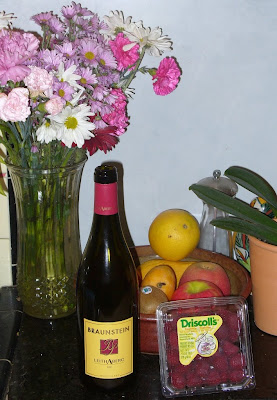 The Braunstein 2004 Leithaberg Rot has a lot going against it, which is probably why I found it several months ago on sale for $20. It's priced at 20 Euros typically, which translates to about $40 for us Americans. Rot just doesn't sound sexy even though all it means is red. Meanwhile, the wine consists of 75% Blaufränkisch and 25% Zweigelt. What kind of rot-blooded American would drink anything other than Zin, Cab or Chard? Blaufränkisch also goes by the aliases Lemberger, Blauer Limberger, Frankovka, Franconia, and Kékfrankos, just to name a few. How are you going to abbreviate it to one syllable for sale to the masses if you don't even know what to call it? And do the masses even know what an umlaut is?
The Braunstein 2004 Leithaberg Rot has a lot going against it, which is probably why I found it several months ago on sale for $20. It's priced at 20 Euros typically, which translates to about $40 for us Americans. Rot just doesn't sound sexy even though all it means is red. Meanwhile, the wine consists of 75% Blaufränkisch and 25% Zweigelt. What kind of rot-blooded American would drink anything other than Zin, Cab or Chard? Blaufränkisch also goes by the aliases Lemberger, Blauer Limberger, Frankovka, Franconia, and Kékfrankos, just to name a few. How are you going to abbreviate it to one syllable for sale to the masses if you don't even know what to call it? And do the masses even know what an umlaut is?In short, we have a rot wine made from a varietal that sounds like a stinky cheese. That's a recipe for a discount, regardless of quality. Since I like value and exploring unfamiliar wine regions--in this case it's Leithaberg in the eastern-most Austrian state of Burgenland--this one was a no brainer.
I didn't know quite what to expect from this wine. Blaufränkisch, according to its Wiki, is a late ripening grape that makes a dark wine with fruity and spicy flavors. Other sources compare it to Merlot and Gamay Noir, and suggest it makes a good introductory wine due to its medium body, lighter tannins and fruit-forward flavors. (Aside: I'm not so certain about the latter statement as new wine drinkers are often most attracted to powerful, oaky wines with varietal names like Cab or Chard or unstructured, slightly sweet wines like Charles Shaw, YellowTail or any generic Pinot Grigio.) Zweigelt, meanwhile, is a cross of Blaufränkisch and St. Laurent that is supposedly more cold hardy and ripens earlier. Since it tends towards high yields, it may produce a pedestrian wine without hard work in the vineyard.
As it turned out, the descriptions were pretty much on-target. The wine was dark in color, but had the medium body and light tannins of a good Pinot Noir. It definitely was not a beginner's wine, though. While there were aromas and flavors of cherries and raspberries, tobacco was the most prominent component of the wine. It was most obvious in the bouquet and the finish where it added a savory layer of complexity to the fruit forward attack. The acidity was medium low, but appropriate for the weight of the wine. There was also a light impression of high quality oak that added some mid-palate presence, yet was wholly complementary.
Wines labeled with the Leithaberg appellation, according to their website, must express their terroir, avoid the international (Parkerized) style, and possess balance and elegance. Having read their PR copy after tasting the wine, I'd have to say that it's 100% true. Not only did this wine express a unique character, it's flat out good.
Even at $40 full retail price, this wine would be fairly priced. I feel like I practically stole it for $20. It's essentially a better and more mature version of the 2007 Pied de la Butte I recently tasted. Then again, I love the tobacco of a good Cab Franc, and I love the supple elegance of a good Pinot Noir. This wine brings both of these qualities together. I'd even hazard to guess that if given more age, the fresh tobacco aromas might evolve into an even more complex cigar box bouquet, though it might come at the expense of some of the delicious fruit this has now.
The Braunstein 2004 Leithaberg Rot is a stunning, awesome wine. I'm adding Leithaberg to my list of regions like Chinon, Bourgueil, Bierzo and Mount Etna that can produce superior medium bodied wines of terroir without the exorbitant prices Burgundy or California will often demand. Everyone should put down their glasses of over-extracted Napa Cabs and go out right now to try something from Leithaberg. If you can find it!
Pros: Tobacco, Red Fruit, Medium Bodied, Balanced, Elegant, Deep, Complex, Seamless, Long Finish
Cons: None
Decant: Yes
Price: $20 from K&L Wines
QPR: Excellent (out of Poor, Mediocre, Fair, Good or Excellent with Fair denoting expectations were met for the price point)




